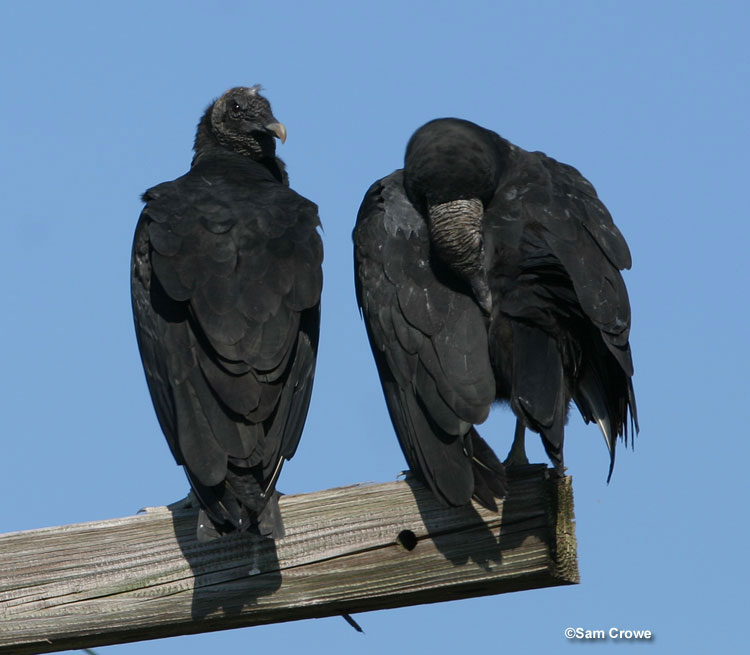The Black Vulture is one of the most common, overlooked bird species in its huge range.
The appearance and scavenging habits of the Black Vulture don’t make it the most popular of birds. However, we can’t deny the essential services it provides in cities, farms, and wilder places.
These scavengers feed on a variety of carrion, garbage, and other waste in habitats as varied as cities, wetlands, open fields, and forest. They are common and easy to see in most of their range, and are only scarce in the northern limits of their distribution.
On this page
Identification
Black Vultures are large, mostly black raptors with long, broad wings, and a short, broad tail. These hefty birds are 25 inches long and have a wingspan of 59 inches.
They also have a naked, grayish-black head and neck with heavily wrinkled skin, and a fairly long, dark bill with a pale tip. The neck of the Black Vulture is also fairly long but can be held tucked in or, when walking or feeding, stretched out. Black Vultures have grayish legs with long toes and short claws, and dark brown eyes.
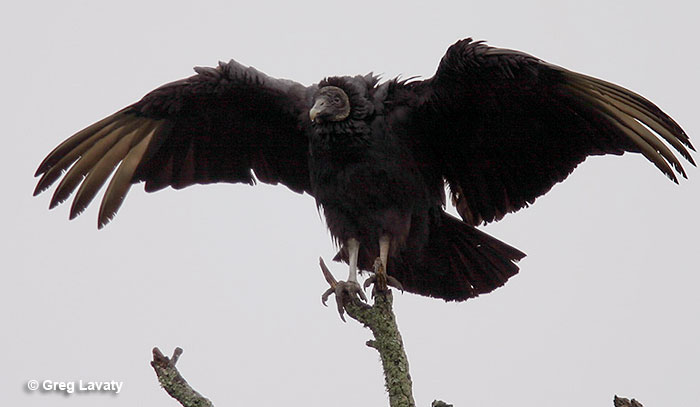
In flight, the wings of the Black Vulture have pale wingtips with long, narrow, primary feathers that look sort of like fingers. Their black head extending out from the body is also very noticeable. This can give the bird a very short-tailed look where the head may seem longer than the tail.
Male Black Vultures look exactly like females, although they tend to be slightly smaller (both weigh around 4.4 pounds).
Juvenile Black Vultures look like adults but have some black feathers on the head and can also have some patches of brown feathers.
The Black Vulture is usually quiet, although it can make hissing sounds and other gruff and guttural noises at roosts and at the nest.
Food
Black Vultures feed almost entirely on carrion. This species will eat a wide variety of items and even garbage but seems to prefer and be adapted to eating medium-sized and large dead mammals.
Some of the more common mammal food items include White-tailed Deer, Raccoons, Armadillos, Groundhogs (Woodchucks), Opossums, and many farm animals. Black Vultures also eat dead poultry, especially in North Carolina, where dead chickens are a main food source. They also feed on dead fish and other scraps on coastlines and in wetlands.
On occasion, this species also takes live prey, especially baby turtles, the eggs of crocodilians (when they can get them), and other small creatures. Rarely, groups of Black Vultures have also been documented attacking, killing, and eating small mammals like skunks and opossums. This mostly happens when carrion is scarce.
Black Vultures forage for carrion by flying high in the air, sometimes up to 3,000 feet or more, and watching the behavior of other Black Vultures and, most of all, the behavior of Turkey Vultures.
When they see a Turkey Vulture or another Black Vulture descend to the ground, Black Vultures quickly follow suit to check out the situation. If carrion is present, they quickly dominate and displace the Turkey Vulture. If they can’t penetrate the skin of the carcass, they wait until a Coyote or another scavenger arrives to do the job.
When feeding, Black Vultures use their long, sharp beak to pick bits of flesh from the dead animal until nothing is left. This species is a true opportunist that also eats the maggots off of carcasses and can take ticks from the backs of cattle, Tapirs, and Capybaras.
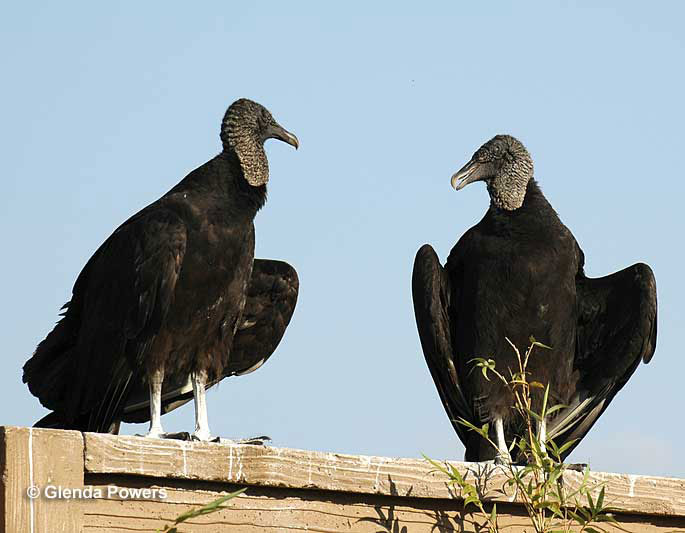
Nesting and Eggs
Black Vultures nest in caves, under dense thickets, on buildings, tunnels, and other cave-like situations. The nest can have some sticks or bones but, usually, nothing is used to build a nest and the eggs are laid directly on the ground.
The female lays two grayish-green eggs with some dark brown blotches, each weighing 104 grams, and both parents incubate the eggs by holding them on top of their toes for 38 to 39 days.
After hatching, young Black Vultures are fed regurgitated food by their parents and can stay in the nest for four months. Even after they leave the nest, some young vultures are still fed by their parents from time to time. One was seen being fed eight months after it had left the nest.
Current Situation
The Black Vulture is a common species in open habitats, woodlands, and many other situations. It lives in much of the southeastern USA north to Ohio and New York, and south to Argentina.
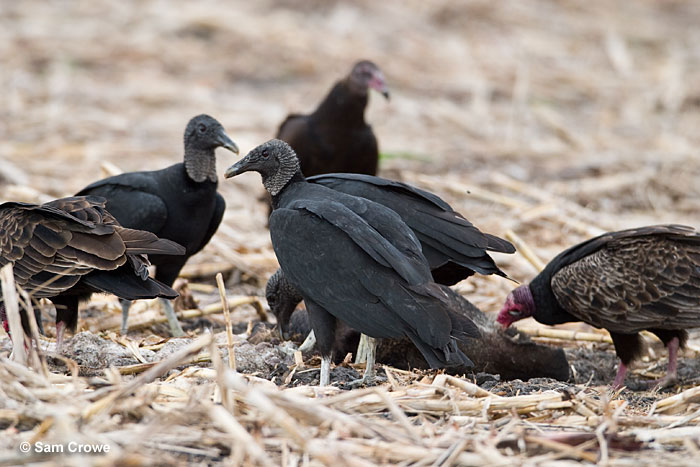
They are especially common in urban areas and coastal habitats in tropical regions. Although this species has been persecuted by cattle ranchers (mostly in the 1800s and early 1900s) who erroneously believed Black Vultures attacked their livestock, the Black Vulture is not endangered. This bird is very common in most parts of its range.
Facts
- Black Vultures have a naked head to keep bits of flesh and other animal waste from sticking to their feathers while feeding on carcasses and other dead animal matter. This adaptation is also found in other vulture species and some storks that eat carrion.
- When an animal dies, Black Vultures are quick to arrive. They much prefer fresh carrion and won’t eat meat that has become too decayed or rotten.
- Unlike many other raptors, the feet of the Black Vulture are weak and adapted to walking and hopping instead of clutching and killing prey. On the rare occasion when Black Vultures attack live prey, they either swallow the small animal whole or tear at it with their bill.
- The feces of Black Vultures are much cleaner than one might expect. Their strong stomach acids kill most disease-causing agents like bacteria, viruses, and fungi.
- Although this species and other vultures were believed to be related to storks, DNA has shown that they form a family more closely related to hawks and eagles.
Similar Species
The Black Vulture is a fairly distinctive bird species easily recognized in much of its North American range. However, at least three other large soaring birds can also be a source of confusion.
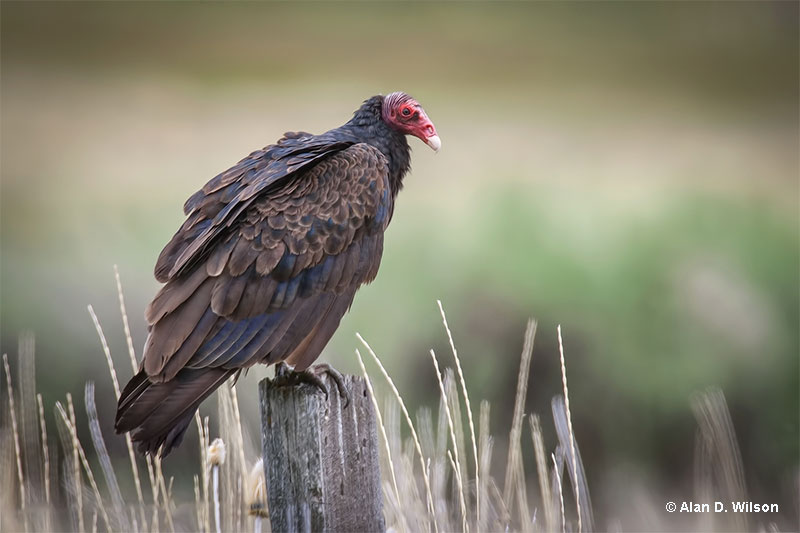
Turkey Vulture
The Turkey Vulture is similar and in the same family as the Black Vulture. However, adults have a small red head and hold their soaring, long wings in a shallow “V” shape.
Black Vultures soar with much flatter wings, have a more prominent pale patch at the wingtips, and have a shorter tail.
Juvenile Turkey Vultures have a dark head but can still be easily separated from Black Vultures by their longer tail and, in flight, by their long wings held in a shallow “V”.
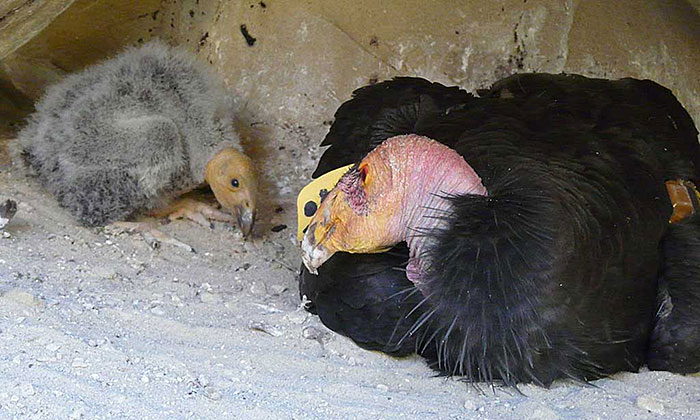
California Condor. Photograph USFWS
Juvenile California Condors also soar with flat, broad wings, and don’t have long tails.
However, these massive birds are much larger than the Black Vulture.
It also has some white on the inner part of the wing and doesn’t usually occur with it.
Frequently Asked Questions
Are Black Vultures rare?
No. Black Vultures are common and easily seen birds in most of their range.
Where are Black Vulture found?
Black Vultures live in open fields, forest, urban areas, and other habitats in the southeastern USA north to Ohio and New York. They also occur in Arizona south to Argentina.
Are Black Vultures aggressive?
Black Vultures are not aggressive around people but bicker with each other and can attack small, helpless animals.
Are Vultures intelligent?
Yes. Vultures appear to be intelligent, social birds that communicate with each other about food sources. They also quickly learn not to be afraid of lights or noises meant to scare them off.
Do Vultures pick up live animals?
No. Vultures have weak feet and cannot pick up live animals.

